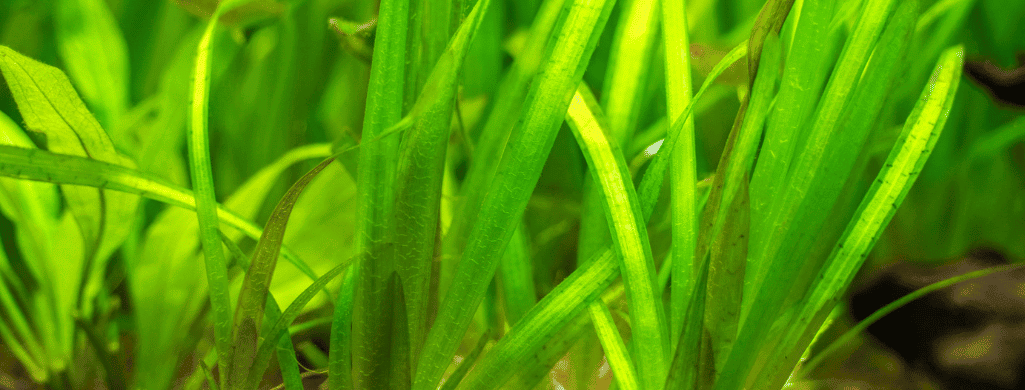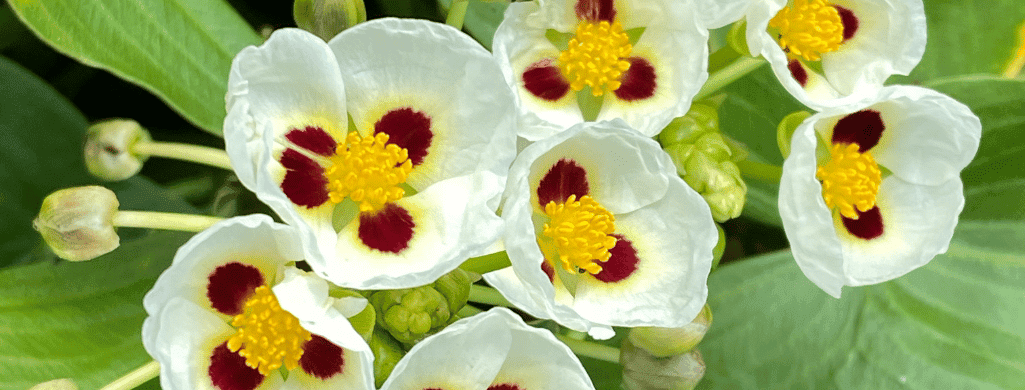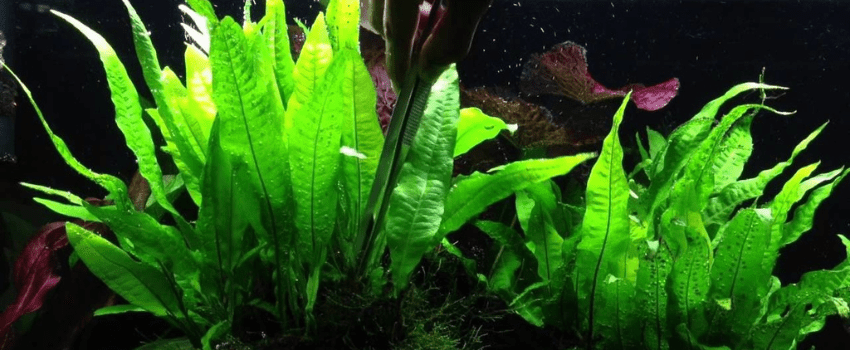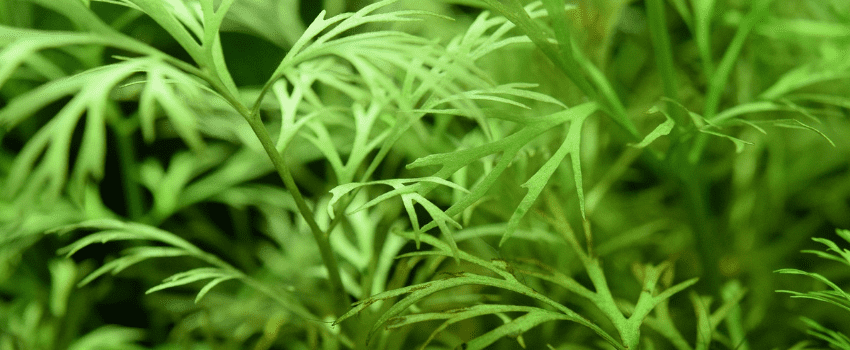Live aquarium plants create a lush, natural environment for your fish.
But can aquatic plants grow in gravel substrate?
Growing aquatic plants in gravel substrate is not easy, but it’s not impossible.
We took the guesswork out of finding the right plants for your aquarium. Check out our list below of the top 20 aquarium plants for gravel substrate.
Top 20 Aquarium Plants for Gravel Substrate
1. Java Moss (Taxiphyllum barbieri)

- Lighting: Low light
- Ideal Temperatures: 70-75° degrees Fahrenheit (21-24°C)
- Size: 2-4″ inches
- Care Level: Easy
- Growth Rate: Slow
Java moss is a hardy plant, making it an excellent choice for beginners.
Instead of roots, Java moss has rhizoids. This means the plant can grow anywhere, including on a gravel substrate.
Planting Java moss on a gravel substrate creates a lush, green carpet. It also grows by attaching itself to rocks and pieces of driftwood.
This plant has a slow growth rate of 1-1.5″ inches per month.
Java moss originates from Southeast Asia. The plant prefers warm water temperatures between 70-75 degrees Fahrenheit.
Since Java moss does not have roots, it absorbs nutrients from the water column.
It grows well in low-light conditions but can tolerate bright lighting, as well.
Java moss creates a nice cover for bottom-dwelling fish and shrimp and adds visual appeal to your aquascape.
2. Anubias (Anubias barteri)

- Lighting: Low/moderate light
- Ideal Temperatures: 72-82° degrees Fahrenheit (22-27.8°C)
- Size: Up to 16″ inches
- Care Level: Easy
- Growth Rate: Slow
Anubias is one of the most popular plants for aquariums. It has dark green broad leaves and can flower underwater.
This plant grows well in low-lighting conditions but can tolerate moderate lighting as well.
Since Anubias is a taller plant, it works well as a midground or background accent.
Anubias has a slow growth rate compared to other aquatic plants. It grows fast with more light but this makes it more prone to algae on the upper leaves.
Keeping Anubias in shady areas or underneath floating plants helps prevent excessive algae growth on the leaves.
This versatile plant can grow in gravel substrate or attached to porous rocks and driftwood.
When planting Anubias in gravel, take care not to cover the rhizome. If the rhizome gets covered, it can rot and kill the entire plant.
3. Cryptocoryne (Cryptocoryne wendtii)

- Lighting: Low/moderate light
- Ideal Temperatures: 72-78° degrees Fahrenheit (22-25.6°C)
- Size: 4-14″ inches
- Care Level: Easy
- Growth Rate: Moderate
Cryptocoryne is a hardy plant and can grow in a range of pH levels and lighting conditions. But this plant grows best in clean water with stable parameters.
There are several different colors of Cryptocoryne, including green, pink, red, and various shades of yellow.
It grows well in low light, but moderate lighting conditions enhance the colors of Cryptocoryne’s wavy leaves.
Cryptocoryne has a robust root system and benefits from nutrients like root tab fertilizers. You must plant Cryptocoryne in at least 3″ inches of gravel substrate for healthy root growth.
Be aware of “Crypt melt” before assuming the worst about your new plant.
When Cryptocoryne gets introduced to a new environment, the leaves wither. You may think your plant has died, but this is a normal process.
Once the Cryptocoryne acclimates to its new environment, it produces healthy new leaf growth.
4. Amazon Sword (Echinodorus bleheri)

- Lighting: Low/moderate/bright light
- Ideal Temperatures: 72-82° degrees Fahrenheit (22-28°C)
- Size: 4-20″ inches
- Care Level: Easy
- Growth Rate: Moderate
Amazon Sword is another excellent choice for beginners due to its easy care and versatility in a wide range of lighting conditions.
With a height of up to 20″ inches, Amazon Sword works well as a background plant.
Its long, bright green leaves provide plenty of cover for your fish.
Plant Amazon Sword in 2.5″ inches of loose gravel for the best results.
This plant has an extensive root system and benefits from added nutrients. Liquid fertilizers and root tabs provide the nutrients Amazon Sword needs for strong roots and healthy growth.
Leave plenty of space around your Amazon Sword, as it can grow very large. Trimming helps manage its growth and prevents the plant from overtaking smaller aquarium plants.
5. Vallisneria (Vallisneria Americana)

- Lighting: Moderate/bright light
- Ideal Temperatures: 64-82° degrees Fahrenheit (17.8-27.8°C)
- Size: 8-16″+ inches
- Care Level: Easy
- Growth Rate: Moderate/fast
Vallisneria is a grassy aquarium plant found in tropical regions of North and South America.
It grows best in bright light but can adapt to low and moderate lighting conditions.
This plant does not need any special care other than occasional trims.
The bright green leaves of Vallisneria grow very tall, sometimes to more than 16″ inches. It works well for hiding heaters and filtration systems for a more natural look in your fish tank.
Vallisneria produces long roots and spreads through runners. A shallow layer of gravel is all this plant needs to establish roots.
Leave the crown of the plant above the substrate so it does not rot.
Because of its long, grass-like leaves, Vallisneria acts as a great natural filter for your tank.
Healthy Vallisneria grows long stalks with small white flowers above the surface.
6. Dwarf Sagittaria (Sagittaria subulata)

- Lighting: Moderate light
- Ideal Temperatures: 68-82° degrees Fahrenheit (20-27.8°C)
- Size: 4-6″ inches
- Care Level: Easy
- Growth Rate: Fast
Dwarf Sagittaria is a grassy plant native to the Atlantic coast of North America and parts of South America.
This plant has narrow green leaves, and when the plant grows above the surface, it produces small white flowers.
Due to its small size, Dwarf Sagittaria looks best as a foreground or midground plant.
Moderate lighting is ideal for Dwarf Sagittaria. Strong lighting causes yellowing leaves, and low lighting slows the plant’s growth rate.
With moderate lighting and proper water conditions, the plant can develop a red color on its leaves.
Dwarf Sagittaria is a heavy root feeder, and its leaves do not absorb many nutrients from the water column.
You must provide extra nutrients when planting Dwarf Sagittaria in gravel substrate. This plant species has a sensitivity to low iron levels.
Signs of iron deficiency in Dwarf Sagittaria include yellowing leaves and stunted growth.
7. Water Wisteria (Hygrophila difformis)

- Lighting: Moderate/bright light
- Ideal Temperatures: 70-85° degrees Fahrenheit (21.1-29.4°C)
- Size: Up to 20″ inches
- Care Level: Easy
- Growth Rate: Fast
Water Wisteria is a fast-growing, bushy aquatic plant native to Southeast Asia.
This plant has a striking appearance with thin, fern-like leaves and a vivid green color.
When grown out of the water, the leaf shapes have a much different appearance. Emersed Water Wisteria produces oval-shaped leaves with jagged edges, much like strawberry leaves.
If you plant an emersed Water Wisteria in an aquarium, it loses these large leaves and grows thinner ones.
Water Wisteria consumes a lot of nitrogen due to its rapid growth. This nitrogen consumption helps reduce algae growth in your fish tank.
You must supplement your Water Wisteria with root tab fertilizers when planting it on a gravel substrate.
8. Java Fern (Microsorum pteropus)

- Lighting: Low
- Ideal Temperatures: 64-82° degrees Fahrenheit (17.8-27.8°C)
- Size: Up to 13″ inches
- Care Level: Easy
- Growth Rate: Slow
Java Fern is one of the most common types of plants available in fish stores. This popular aquarium plant thrives in low-light conditions and has basic care needs.
This broadleaf aquatic plant grows up to 13″ inches tall in an aquarium environment. In the wild, Java Ferns can reach a height of three feet!
The wide leaves provide shade and hiding spots for your fish.
Java Ferns can grow in gravel or attached to rocks and tank decorations like driftwood. Do not cover the rhizome in gravel, or the plant could die.
Rhizome plants like Java Ferns get most of their nutrients from fish waste. Adding essential nutrients through supplements and liquid fertilizers increases the plant’s growth rate.
Trimming your Java Fern close to the rhizome encourages new growth.
Avoid strong lighting with your Java Fern. Bright light can cause melting, which kills the plant over time.
9. Ludwigia (Ludwigia repens)

- Lighting: Medium/bright light
- Ideal Temperatures: 75-79° degrees Fahrenheit (23.9-26.1°C)
- Size: 12-20″ inches
- Care Level: Easy
- Growth Rate: Fast
Ludwigia is an aquatic plant with dense foliage and usually grows in tropical regions of North and Central America.
The large leaves can have dark green, red, or reddish-brown colors. Strong lighting conditions enhance this plant’s red coloring.
Since Ludwigia grows up to 20″ inches tall, you may consider trimming it when it grows up the waterline. But when the plant does grow above the surface, it produces small yellow flowers.
Ludwigia needs a steady nutrient supply due to its fast growth rate.
When planting Ludwigia in gravel, you must add extra nutrients through root tabs or liquid fertilizers.
Always use fertilizers with caution if you have shrimp in your tank. Many aquatic plant fertilizers contain copper, which can kill your shrimp.
10. Moneywort (Bacopa monnieri)

- Lighting: Moderate/bright light
- Ideal Temperatures: 72-82° degrees Fahrenheit (22-27.8°C)
- Size: Up to 12″ inches
- Care Level: Easy
- Growth Rate: Slow
Moneywort is a slow-growing plant found in tropical regions all over the world.
This versatile plant creates a beautiful carpet when planted in the substrate. But it also does well as a floating plant.
When Moneywort grows above the surface, it sprouts tiny yellow and white flowers.
Plant Moneywort at least 1-2″ inches deep in your gravel substrate. This ensures the plant stays anchored and does not float to the top of the tank.
Moneywort does not need added nutrients, but lighting is important. Without enough light, the round leaves fall off, and the plant dies.
Regular trims keep this carpeting plant nice and neat when planted in the substrate.
11. Hornwort (Ceratophyllum demersum)

- Lighting: Moderate light
- Ideal Temperatures: 68-79° degrees Fahrenheit (20-26°C)
- Size: Up to 120″ inches
- Care Level: Medium
- Growth Rate: Fast
Hornwort is a bushy aquatic plant with clusters of green stems and thin, needle-like leaves.
This plant can grow in the substrate or float on the surface. But if you plant Hornwort in gravel substrate, you must take some precautions.
Since Hornwort lacks true roots, planting it in a gravel substrate is a bit of a challenge.
The plant produces rhizoids instead of roots. These rhizoids help anchor the plant.
If you bury the stems in your substrate, this part of the plant rots away.
Instead, you must weigh down the Hornwort with small pebbles until it produces rhizoids and supports itself. Be gentle when weighing the plant down so you do not damage it.
Hornwort works as an excellent filter due to its fast growth. But, the plant may absorb all the excess nutrients in your water column.
When this happens, your Hornwort plant suffers from nutrient deficiencies.
Resolve this issue by adding essential nutrients like iron supplements and liquid fertilizers.
Frequent trims prevent the plant from overtaking your aquarium.
12. Java Fern Windelov (Microsorum pteropus ‘Windelov’)
- Lighting: Low light
- Ideal Temperatures: 68-82° degrees Fahrenheit (20-27.8°C)
- Size: 4-7″ inches
- Care Level: Easy
- Growth Rate: Slow
Java Fern Windelov has the same care needs as regular Java Fern. But there are a few key differences between these two plants.
Instead of solid broad leaves, Java Fern Windelev leaves have a lacy appearance. These leaves branch out and form a pattern like deer antlers.
This type of Java Fern also stays compact, with a size range of 4-7″ inches.
Low light maintains a stable growth rate in Java Fern Windelev. Strong lighting conditions cause brown or transparent leaves.
Much like Hornwort, you must weigh down the base of a Java Fern Windelev when planting it on a gravel substrate. Once the plant grows rhizoids, it anchors to the gravel.
Keep the gravel around the plant loose so it does not suffocate the rhizoids as they grow.
13. Rotala (Rotala indica)

- Lighting: Moderate light
- Ideal Temperatures: 68-82° degrees Fahrenheit (20-27.8°C)
- Size: 4-8″ inches
- Care Level: Easy/medium
- Growth Rate: Fast
Rotala is a unique, bushy aquarium plant also known as Indian Toothcup.
It stands apart from other aquatic plants because of its growth pattern.
Oblong leaf blades grow from delicate, upright stems. These leaves are usually a vivid green color, but they develop a pink or red color near the top of the plant.
Moderate to strong lighting conditions enhance these red leaf colors.
Without enough light, the stems of this plant grow thin, and the leaves turn yellow.
Rotala absorbs nutrients from both the substrate and the water column.
Bury the plant in your substrate at least 2″ inches deep. This helps anchor the plant’s roots.
Use a root tab fertilizer when planting Rotala in a gravel substrate. The fertilizer supports healthy plant and root growth.
Regular pruning prevents overgrowth of Rotala and lets light reach the bottom leaves so they do not turn yellow.
When Rotala grows above the surface, it can produce tiny purple flowers.
14. Marimo Moss Ball (Aegagropila linnaei)

- Lighting: Low/moderate light
- Ideal Temperatures: 43-75° degrees Fahrenheit (6.1-23.9°C)
- Size: Up to 12″ inches
- Care Level: Easy
- Growth Rate: Slow
Marimo Moss Balls are not plants, but they are a unique and rare form of algae growth.
They grow in lakes around the world and are most famous for growing in Lake Akan in Hokkaido, Japan. The moss can tolerate a wide range of temperatures and pH levels.
These moss balls are good luck charms in Japan and can live for up to 200 years. As a symbol of close bonds, they are usually passed down to future generations.
Marimo Moss Balls have a very slow growth rate. A 2″-inch diameter Marimo Moss Ball is around 8-15 years old.
The largest Marimo Moss Ball on record was around 12″ inches in diameter!
They get their round shape from water movement. But Marimo Moss also grows as a carpet by attaching to surfaces like shaded rocks and driftwood.
15. Dwarf Baby Tears (Hemianthus callitrichoides)

- Lighting: Medium/bright light
- Ideal Temperatures: 68-75° degrees Fahrenheit (20-24°C)
- Size: 1-2″ inches
- Care Level: Medium/difficult
- Growth Rate: Slow
Dwarf Baby Tears create a beautiful carpet of creeping stems and small, bright green leaves.
A unique feature of this plant is the formation of small bubbles of oxygen on the leaves. The formation of these tiny bubbles is what aquarists call “pearling.”
Unlike most of the other plants on our list, Dwarf Baby Tears are not suited for beginners.
This plant is very sensitive to temperatures higher than 75 degrees Fahrenheit. It also has a weak root system and needs steady carbon dioxide injection for healthy growth.
Dwarf Baby Tears are also prone to iron deficiencies.
The gravel size matters when planting Dwarf Baby Tears. You must use a fine gravel substrate because of this plant’s delicate root system.
If the gravel is too large, the roots have a difficult time spreading.
16. Water Sprite (Ceratopteris thalictroides)

- Lighting: Moderate/bright light
- Ideal Temperatures: 70-82° degrees Fahrenheit (21-27.8°C)
- Size: Up to 12″ inches
- Care Level: Easy
- Growth Rate: Fast
Water Sprite is an aquatic fern with lush, green leaves and easy maintenance. It can grow on the substrate or float on the surface.
Moderate or bright light setups encourage healthy growth. It can tolerate low-light conditions, but this causes slower growth.
This plant grows in tropical conditions around the world.
Water Sprite has thick green stems with delicate, feather-like leaves. It works best as a midground or background plant because of its height.
The long roots of this plant help it absorb nutrients and keep it anchored to the substrate.
But the roots of Water Sprite are a bit fragile and brittle. Using a fine gravel substrate keeps the delicate roots from breaking as the plant grows.
Fertilizers and carbon dioxide injections are not needed for healthy growth.
17. Monte Carlo (Micranthemum ‘Monte Carlo’)
- Lighting: Medium/bright light
- Ideal Temperatures: 68-77° degrees Fahrenheit (20-25°C)
- Size: 1-2.25″ inches
- Care Level: Easy/medium
- Growth Rate: Moderate
Monte Carlo forms a lush, magnificent carpet of light green round leaves and creeping stems. This carpeting plant is very popular among aquatic plant enthusiasts.
Like Dwarf Baby Tears, Monte Carlo also forms tiny oxygen bubbles on its leaves under ideal conditions.
Its long stems can sprout small white flowers at the ends.
The native habitat of this aquatic plant includes marshes and riverbanks in South America.
Bright lighting accelerates the horizontal growth of Monte Carlo. Low-light setups are not suitable for this plant.
A nutrient-rich aquarium soil is an ideal substrate, but a fine aquarium gravel substrate also works well with this plant. Ensure the gravel is loose and not compacted.
Liquid fertilizer provides an adequate nutrient supply to Monte Carlo. Carbon dioxide is not needed, but it can jumpstart growth and thicken the beautiful carpet.
Regular trimming keeps Monte Carlo neat and prevents it from overgrowing.
18. Banana Plant (Nymphoides aquatica)

- Lighting: Moderate/bright light
- Ideal Temperatures: 68-81° degrees Fahrenheit (20-27°C)
- Size: 2-12″ inches
- Care Level: Easy
- Growth Rate: Moderate
The Banana Plant has a unique look because its tubers look like tiny bananas.
Some people mistake the tubers for roots. But burying them in the substrate makes them rot.
These tubers store the plant’s nutrient supply.
A Banana Plant’s roots grow from the stem and are usually white or light green.
While the plant produces many leaves underwater, it also sends a runner to the surface.
This runner can grow to a height of 28″ inches and grows a lily pad on the surface.
Plant no more than 1/3 of the Banana Plant’s tubers in your gravel substrate. Any deeper than this, and the tubers can rot.
You must add root tab fertilizers so the plant receives proper nutrition.
19. Red Tiger Lotus (Nymphaea Zenkeri)

- Lighting: Moderate/bright light
- Ideal Temperatures: 71-82° degrees Fahrenheit (21.7-27.8°C)
- Size: 5-25″ inches
- Care Level: Easy
- Growth Rate: Fast
Red Tiger Lotus is a stunning aquarium plant with bright red heart-shaped leaves. The leaves can develop variegation in optimal light conditions.
This plant can grow long stems up to the surface and produce heart-shaped lily pads. These lily pads produce large blue or white flowers.
Bright to moderate lighting keep the plant compact.
Bury the roots of the Red Tiger Lotus, but leave the bulb exposed.
Supply plenty of root tab fertilizers to your soil so the plant receives adequate nutrients.
20. Bucephalandra (Bucephalandra)

- Lighting: Moderate/bright light
- Ideal Temperatures: 72-84° degrees Fahrenheit (22-29°C)
- Size: 2-4″ inches
- Care Level: Easy
- Growth Rate: Slow
Bucephalandra is an attractive aquarium plant with green, blue, or dark violet leaves.
The leaf size and shape vary depending on the species. Leaf shapes found in Bucephalandra include oval, long and straight, long and wavy, and round and wavy.
Bucephalandra leaves also develop small yellow spots as a result of photosynthesis.
Bright light brings out the colors in this plant. Low light prevents color changes, and the plant stays green.
Adding fertilizers to your aquarium also encourages more vivid leaf colors.
When planting Bucphalandra in a gravel substrate, leave the rhizome exposed. You must use a larger gravel size for anchoring this plant’s strong root system.
Because of its slow growth rate, Bucephalandra is more prone to algae growth. Keeping the water clean helps prevent excessive algae growth.
Let It Grow!
Gravel substrate comes in a wide range of colors, sizes, and shapes. Choosing the correct type of gravel for your plants avoids issues with root growth.
The best types of plants for a gravel substrate are water column feeders. These plants access nutrients from the water column through their leaves instead of their roots.
But heavy root feeders can thrive with root tab fertilizers.
Always maintain clean water parameters and ideal lighting conditions in your aquarium. This also encourages healthy growth in your plants.


